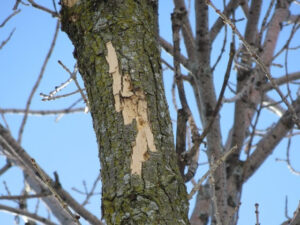Photo credit: Wisconsin DNR
Watch for woodpecker damage to your ash trees this winter. The Wisconsin DNR says if you find damage, you should make plans to take action this spring.
Woodpecker damage, often called “flecking,” happens when birds peck away some of a tree’s bark to access the larvae underneath. Flecking is a common early sign that an ash tree has emerald ash borer, an invasive insect. EAB is the most damaging threat to Wisconsin trees, killing more than 99 percent of the untreated ash trees it infests.
In 2023, three additional Northern counties in Wisconsin found emerald ash borer. The insect is now present in 69 of Wisconsin’s 72 counties. It is a common insect in the southern half of the state and woodpecker damage to ash trees is already widespread. EAB infestations are currently uncommon in most parts of northern Wisconsin, and woodpecker damage will be less abundant.
Landowners who spot woodpecker damage in their woodlot ash trees should consult a DNR or consulting forester for management advice.
Property owners who detect an emerald ash borer infestation in its early stages — often by looking for woodpecker damage — can take steps to protect their high-value ash trees by treating them with insecticide between mid-April and mid-May. Insecticide treatments are seldom practical or economical for woodlot ash trees.
Insecticide treatment of valuable ash trees is more likely to succeed if the trees have low or moderate levels of woodpecker damage. Now is a good time to make plans for insecticide protection this spring.
Learn more: https://datcpservices.wisconsin.gov/eab/index.jsp
Flecking usually starts in a tree’s canopy and progresses down the tree over the next few years if the tree is not treated. Other signs and symptoms of emerald ash borer infestation include:
- Sprouts growing from the base or trunk of the tree.
- A thinning canopy with smaller, pale leaves.
- Small (one-eighth of an inch), D-shaped exit holes in the bark.
- Green beetles crawling on the trunk of ash trees during the summer.


